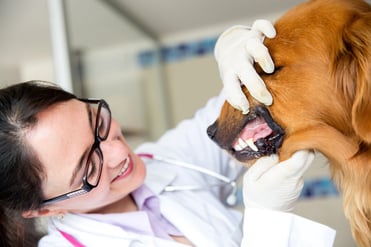Dental hygiene is important for both pets and humans. Just like you and I, cats and dogs may suffer from periodontal disease. Studies have suggested that 85% of all pets develop periodontal disease by the age of three. It is a progressive disease of the tissue surrounding the teeth, and is the main cause of tooth loss.1
There is not much difference between canine, feline and human teeth. We all grow a set of baby teeth that eventually fall out to allow adult teeth to settle in. Also, we share a similar network of nerves and blood vessels around our teeth, surrounded by dentin, which is then surrounded by a hard coat of enamel.2 Our pets’ teeth get bathed in saliva, bacteria and food particles that eventually form plaque. Then, minerals within the saliva bond with the plaque, giving way to tartar, a hard substance that adheres to teeth if not taken care of properly. Professional cleaning is needed to remove plaque and tartar that develops below the gum line.
Although there are canine dental products available at several pet shops, such as toothbrushes and paste, it is very difficult to train dogs, and even harder for a cat, to tolerate frequent brushing and cleaning. A veterinary dental cleaning is the best choice to remove tartar from pet’s teeth and under the gums to protect their health. The problem with tartar is that it helps bacteria to grow under the gums, causing gingivitis, which is reversible if found in its early stages. If not addressed properly, bacteria starts destroying the supporting tissue around the tooth, leading to tooth loss or periodontitis. Periodontitis is not reversible and once it enters the animal’s bloodstream it infects other organs, like the heart, kidneys and liver.

It is important to take pets to the vet for annual check-ups. The veterinarian can do an oral assessment while pets are awake, but for a complete examination and clean-up, anesthesia is necessary. It is very hard, if not impossible, to perform a complete oral cleaning on a pet without general anesthesia. When you visit the dentist, you know what is being done to keep your teeth healthy, and you do your best to cooperate and lay still. Most animals do not understand what is going on, or why they need a dental clean-up, so they react by trying to get away, or biting. Anesthesia is the only way a dental procedure can be carried out without stress or pain for pets.3
Although there are some risks associated with the use of anesthesia, the procedure is continuously improving. The American Animal Hospital Association (AAHA.org) recommends full intubation for all adult dogs and cats that must undergo a dental cleaning. In addition, the veterinarian examines pets to make sure they are healthy enough to undergo the process. A pre-anesthetic exam should include:
- Blood tests
- Urine tests
- Electrocardiography
- X-rays
While pets are under anesthesia, their vital signs should be monitored and recorded. A soft plastic endotracheal tube is inserted to help them breathe during the procedure, and it also minimizes the risk of tartar, water, and cleaning solutions going into the pet’s lungs.4 This tube also prevents inhalation of bacteria that gets aerosolized during a dental cleaning. Under anesthesia, the dental cleaning procedure should include:
- Removing of plaque from teeth and under the gum
- Probing of dental sockets for assessment
- Dental X-rays
- Removal of fractured or infected teeth
- Polishing teeth with a special paste
- Application of an anti-plaque substance, like fluoride, to help strengthen teeth and prevent future plaque’s growth
There are some assessments pet owners can do at home to decide if it’s time to take their pet to a veterinarian for a full dental check and clean-up. Animals’ breath is not usually great smelling, but you can be aware of the following:
- Foul breath
- Broken or loose teeth
- Abnormal chewing or dropping food while eating
- Reduced or loss of appetite
- Pain and bleeding from the mouth or gums
- Swelling areas in the mouth
Even though the American Veterinary Dental College does not recommend dental cleanings without anesthesia, there are certain treats that claim to improve dental health. If your pet allows you to brush their teeth, you may do so, and it may reduce the frequency of a thorough dental cleaning. However, it is important to include dental care as part of your pet’s preventive health care program. Dental disease, if let untreated, can lead to more serious health complications. The benefits of a pet’s dental hygiene are countless, including increased longevity and better overall health for your beloved furry companion.5
Feel free to browse though our full line of veterinary instruments by clicking the button below.
References:
1 Dental Cleaning for Dogs and Cats. (2014, February).
2 Riggs, Rex Dr. (2010, February). Guest Post: Why have your dog’s teeth cleaned by a Vet anyway?
3 Pet Dental Care. (2016).
4 AAHA Dental Care Guidelines for Dogs and Cats. (2016).
5 Shafford, Heidi DVM. (2014, June). Why it’s Important to Have Your Dog’s Dental Cleanings Performed Under Anesthesia.


